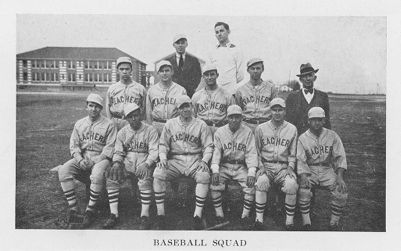
In 1910, male students organized a baseball squad that competed locally against high school teams. However, t”he squad did not last another year, fading into oblivion as athletics at ECTTS came to be defined, along utilitarian lines, in terms of what served the greatest good for the greatest number. That meant athletic activities primarily for women, including basketball, tennis, and cross-country walking. With increases in the male student population in the 1930s, momentum for male sports rose, leading to, in the 1932-1933 academic year, the appearance of three men’s teams: football, basketball, and baseball. These three were featured in the 1933 Tecoan, with photographs for the “football group,” “basketball squad,” and “baseball squad,” along with those captions, but nothing more. The 1934 Tecoan included pictures of the football team and the “basketeers,” but nothing on the baseball team. The 1935 Tecoan included nothing on men’s sports whatsoever. The yearbook, dominated editorially by women, did not assign much significance to men’s sports initially. The team’s overall record its first two years, 4-8-0, did little to suggest otherwise.
By 1934, men had established themselves in positions of editorial power in the student newspaper, the Teco Echo. Soon, a new section appeared, “Sports,” edited by George S. Willard, Jr., future editor-in-chief, offering regular coverage of Pirate baseball games. Reflecting the new masculine journalism, the sports page invariably called baseball players “the Pirates,” even though team photographs revealed ill-fitting uniforms still emblazoned with “Teachers.” Despite this dissonance in moniker, the ECTC baseball team received the energetic support of sports editor Willard. The sports page banner regularly implored students to support the team. First coached by C. Kenneth Beatty, the baseball team, as of 1934, gained a new coach, Dr. A. D. Frank, a professor of history and sports enthusiast. Frank also coached the women’s basketball team. In early baseball competition, the ECTC Pirates played Presbyterian Junior College, Fort Bragg, Grimesland, Oak Ridge Institute, Atlantic Christian College, Louisburg College, and High Point College. At the end of the season, the “Sports Comments” column congratulated Dr. Frank and the Pirates for having “greatly improved,” winning “half of the games played.”
Sports editor Willard, writing in 1934, noted that while the team had not won many games, it received “comparatively very little financial backing.” Thus, he asked, “how can we expect the Pirates to rank equally with athletes who receive compensation of some kind for playing ball?” Later that spring, Willard’s “Sports Comments” column complained about the “comparatively poor support the baseball team has had thus far,” adding that the college’s standing as one primarily for women “should be no legitimate reason why school spirit is decidedly lacking in many of the student functions.” Hyping the baseball team’s achievements, the Teco Echo published a large “action” photo collage of the “successful Pirates,” with players’ names added, centered around Coach Frank. In the end, the Pirates finished the 1934 season with a much-improved record, 5-7. The Teco Echo added, optimistically, that even in games lost, the team always scored.
As the sport gradually captured campus attention, later Tecoans gave it fuller coverage. Beginning in the spring of 1936, a new coach, Roland “Bo” Farley, made headlines as the prospective leader who would take the baseball team to new heights. Farley had been a three-letter athlete at Duke, former director of athletics at Danville High School, manager of the Greenville Baseball Club in the summer of 1935, and was at the time, director of athletics at Greenville High School. Moreover, he had played semi-professional baseball for one year. At ECTC, where Farley completed his undergraduate degree, he accepted a position as coach for all three men’s sports – football, baseball, and basketball. But clearly his strength was in coaching baseball, and it was in that capacity that he made his mark.
Farley’s first year, 1936, saw the Pirates achieve a winning record, 6-4-1. The 1937 season brought even more success with an 11-5-2 record. That year, eight players ended the season with a .300 or higher batting average. Farley’s tenure with Pirate baseball, 1935-1938, was brief, but his impressive overall record of 35-14-4 (.698) well established a winning momentum that helped propel baseball forward as one of East Carolina’s premier male sports rather than allowing it to drift into oblivion as the earlier, premature start had less than three decades prior.
Sources
- “Action Photo Of Successful Pirates.” Teco Echo. May 16, 1934. Vol. 10, no. 13. P. 3. https://digital.lib.ecu.edu/38018
- “Baseball.” Tecoan. 1937. Greenville, N.C.: East Carolina Teachers College, 1937. Pp. 184-185. https://digital.lib.ecu.edu/15342
- “Baseball.” Tecoan. 1938. Greenville, N.C.: East Carolina Teachers College, 1938. Pp. 196-197. https://digital.lib.ecu.edu/15343
- “Baseball Notes.” Tecoan. 1936. Greenville, N.C.: East Carolina Teachers College, 1936. Pp. 156-157. https://digital.lib.ecu.edu/15341
- “Baseball Squad.” Tecoan. 1933. Greenville, N.C.: East Carolina Teachers College, 1933. P. 161. https://digital.lib.ecu.edu/15338
- “Sports Comments.” Teco Echo. April 25, 1934. Vol. 10, no. 12. P. 3. https://digital.lib.ecu.edu/38017
- “Sports Comments.” Teco Echo. May 30, 1934. Vol. 10, no. 14. P. 5. https://digital.lib.ecu.edu/38019
- “Sports Comments.” Teco Echo. May 16, 1934. Vol. 10, no. 13. P. 3. https://digital.lib.ecu.edu/38018
Citation Information
Title: The First Baseball Team
Author: John A. Tucker, PhD
Date of Publication: 10/11/2019